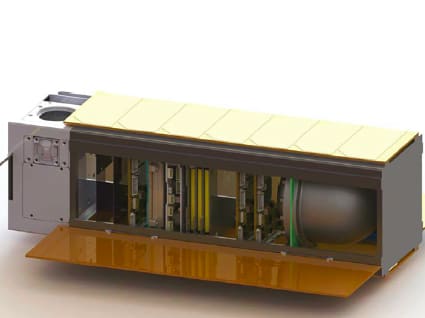
Recent advancements in space technology have resulted in space exploration becoming a rapidly growing field, and the desire for human space exploration is drastically increasing. Previous manned missions include flights to low Earth orbit (LEO), such as to the International Space Station (ISS); however, upcoming flights are planned to go beyond LEO, such as to asteroids and eventually Mars. A major consideration in such missions is that the space environment is significantly different from that of Earth, especially with respect to the radiation environment. This drastic difference results in concerns regarding radiation dose.
Space radiation is distinct from naturally occurring forms of radiation on Earth, and significant health risks are associated with long-term exposure, including cancer, cataracts, central nervous system damage, acute radiation sickness, and hereditary effects. Consequently, the fulfillment of the intended exploration goals of each mission must be carefully managed without exceeding an acceptable level of risk from exposure to space radiation. Therefore, there exists a need for radiation detection systems that are able to classify and characterize the radiological hazards present.

The NEUtron DOSimetry & Exploration (NEUDOSE) mission concept grew out of the need to develop advanced radiation dosimeters that lower the risk of deep space missions by providing superior radiation exposure monitoring. The mission goals are to develop a Charged & Neutral Particle Tissue Equivalent Proportional Counter (CNP-TEPC) that allows for the discrimination of dose from charged and neutral particles, and map the contribution to in vivo doses from charged and neutral particles in LEO. McMaster University in Ontario, Canada, one of the world’s foremost institutions on health effects from radiation exposure, addressed this challenge.
The project is led by Dr. Andrei Hanu, who is currently working at NASA’s Goddard Space Flight Center in Greenbelt, MD. A team of undergraduate students from the university is designing, fabricating, and planning to launch a small satellite, or CubeSat, into low Earth orbit in order to study the effects of ionizing radiation on the human body. The team includes medical physics, electrical engineering, computer engineering, mechanical engineering, mechatronics engineering, and engineering physics students.
For the project to be successful, it is important that each component is thoroughly inspected to ensure accuracy and functionality. The Mantis Elite-Cam stereo microscope, manufactured by Vision Engineering (New Milford, CT), has been chosen for this task. Mantis Elite-Cam bridges the gap between the microscope and the bench magnifier, and with eyepiece-less technology, users can inspect accurately for longer periods. This means students don’t suffer from the neck ache or fatigue usually associated with using a traditional microscope.

The Mantis Elite-Cam will primarily be used to inspect the PCBs and other small components of the satellite found on the main instrument of the payload and the Tissue Equivalent Proportional Counter (TEPC), a device that measures the amount of harmful radiation for astronauts in low Earth orbit. The outer layer of NEUDOSE’s CNP-TEPC radiation detector is made from a plastic scintillator material. When charged particles in space interact with this hemispherical detector, light is emitted. By collecting this light, it is possible to determine that the radiation passing through the detector is a charge carrier. This is the first step in how the CNP-TEPC can distinguish charged particles from neutral radiation.
The Mantis Elite-Cam will also be used during the building of the main onboard computer and the satellite’s communications device. The integrated camera of the Mantis Elite-CAM will allow the students to capture images from inspection, aid in reflow soldering, and use the device as a teaching tool.
The secondary use of the Mantis Elite-CAM will be for all other quality assurance; for example, the inspection of the solar panels, the flywheels (which control the orientation of the satellite), and the structure itself. The satellite measures only 10 x 10 x 30 cm, and is filled with equipment and technology.
For more information, Click Here .

